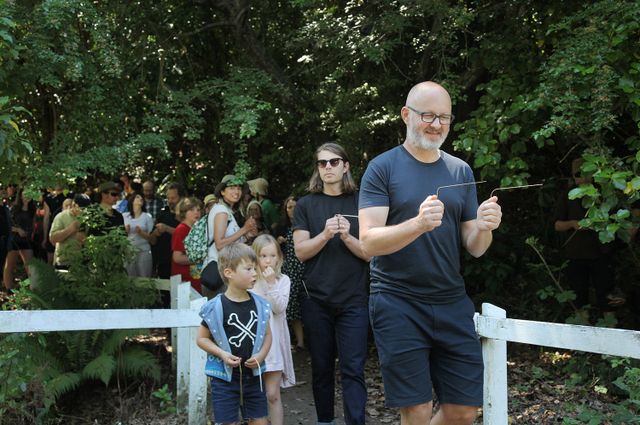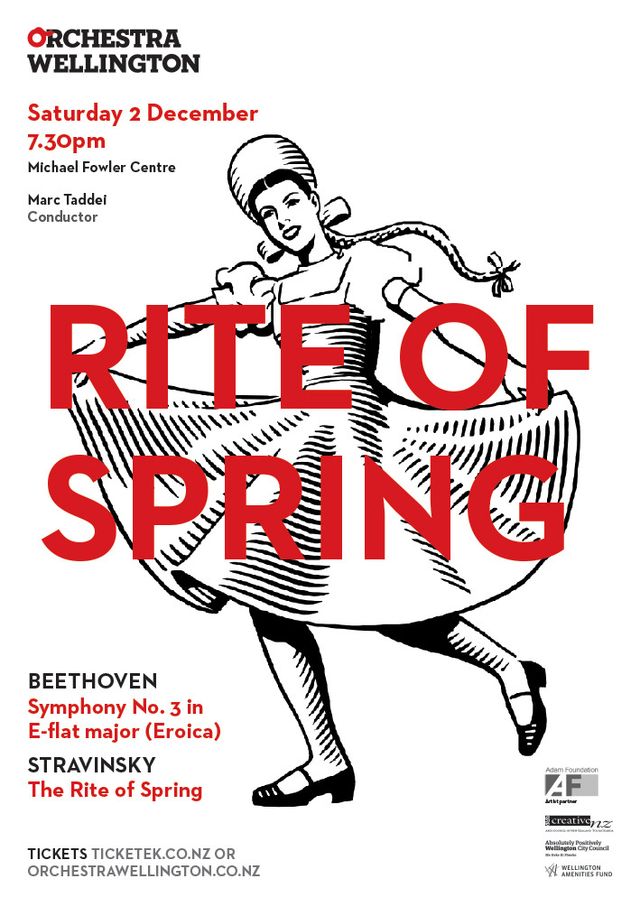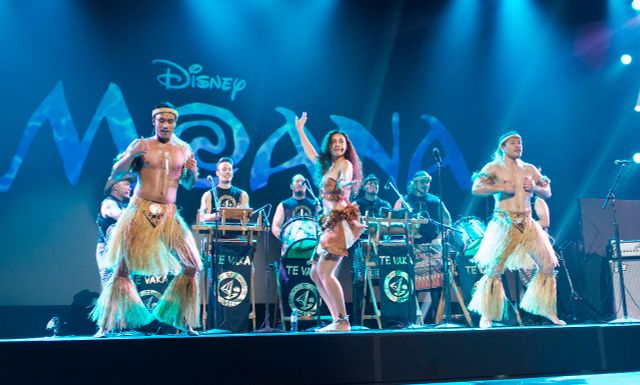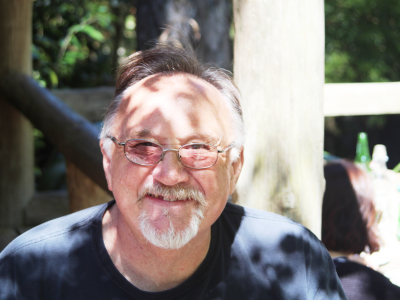Performing Arts / November 2017
December 2017 | October 2017-
-

Dunedin artists boosting environmental awareness and biodiversity
- Urban Dream Brokerage
- <figure class=" sqs-block-image-figure intrinsic " > Josh Thomas (an Urban Dream Brokerage Advisory Board member) heads the water diviners at the opening of Awa HQ. Image: Justin Spiers. Water divining in the Dunedin town belt has kicked off the first of two innovative public art commissions, which sees artists respond to the city’s environmental needs as part of Te Ao Tūroa, Dunedin’s Environment Strategy. In a programme called Environment Envoy, Dunedin’s Urban Dream Brokerage announce two projects following a call for proposals in August: Awa HQ, a collaboration by Angela Lyon, Aroha Novak and Charlotte Parallel dedicated to Dunedin’s Toitū stream, and What Grows Where You Live, a project led by artist Ruth Evans involving revegetation and artwork creation with native plant species. The commissions, worth $6500 each, are part of Dunedin's Urban Dream Brokerage service, funded by Dunedin City Council and supported by national public art organisation Letting Space. “We are working to encourage Dunedin’s community to see their local environment in new ways, and specifically to get more action happening to increase biodiversity,” says Dunedin City Councillor and Te Ao Tūroa Partnership Chair David Benson-Pope. “The city is also using and creating strong partnerships between different sectors to deliver a better natural environment. Artists have a vital role to play in all of this – from making new connections and encouraging partnerships to enabling people to see their world from completely different perspectives.” Awa HQ acknowledges Toitū stream, hidden within Dunedin’s CBD, provides a vital connection to Dunedin’s environment and heritage. The project looks at the history, condition and relationships of the stream by gathering together diverse stories, experiences and responses. Treating the stream as a living entity, the artists were inspired by the passing of the Whanganui River Claims Settlement Bill, which in March which gave the Whanganui River, Te Awa Tupua, the same status as a legal person. The project was launched with a picnic and a water divining hikoi with Stephen Kilroy and Taonga Pūoro artists Jennifer Cattermole and Jessica Latton on 25 November. They are now inviting other artists to respond to their call this coming weekend Saturday 9 December 12pm to 4pm by presenting work at Awa HQ, an empty lot at 175 Rattray Street, Dunedin, beside the now concealed stream. Featuring a range of performances, actions, discussions and picnics Awa HQ will culminate in a final hikoi on Saturday 17 February 2018. The second project What Grows Where You Live embraces the biodiversity available in Ōtepoti/Dunedin. Focusing on the plant species raupo, harakeke, kowhai and poroporo, the project begins by working with private and public landowners to introduce native flora across the greater Dunedin region through planting schemes. Materials will be gathered from these sites to be used in constructing art works hosted in a vacant space in Dunedin’s CBD in April 2018. The exhibition will feature workshops for skills and knowledge sharing, and a zine providing understanding of where these plants grow, how to source them, and their traditional application in Māori society. “The Environment Envoy projects will engage more of our community in the work to achieve the goals of Te Ao Tūroa,” says Councillor Benson-Pope, “and also strengthen collaboration between artists and the public, iwi, scientists, councils, business and community groups. We all have a key role to play in enhancing our environment.” For more information: contact Katrina Thomson email: envoy.udb@gmail.com
- Accepted from Urban Dream Brokerage Blog by tonytw1
- Tagged as:
- exhibitions
- town-belt
-
-
-

Orchestra Wellington presents RITE OF SPRINGTwo works that...
- Orchestra Wellington
- Orchestra Wellington presents RITE OF SPRING Two works that changed the course of musical history SATURDAY DECEMBER 2, 7:30PM MICHAEL FOWLER CENTRE, WELLINGTON Ludwig van Beethoven Symphony No 3 in E-flat Major, Op 55 “Eroica” Igor Stravinsky The Rite of Spring Marc Taddei, Conductor Orchestra Wellington’s 2017 season goes out with a bang, in a concert combining two of the greatest pieces of music ever written, conducted by music director Marc Taddei. First, Beethoven’s mighty Eroica Symphony features on Saturday 2nd December at the Michael Fowler Centre. At the other end of the concert, the orchestra is performing the one work which can top Beethoven’s in terms of its impact, Stravinsky’s Rite of Spring. “I’m extraordinarily excited to present the defining works of the 19th and 20th century for our grand finale concert,” says conductor Marc Taddei. “Music would never be the same after the Eroica and The Rite of Spring. The sense of drive, power and rhythmic impulse connect these two monuments of Western civilisation.” Beethoven’s Eroica caused a sensation when it was first performed in 1803, a hundred years later, Stravinsky’s Rite of Spring started a riot. Beethoven demanded the orchestra play a series of discords so shocking to audiences, many of them thought he had gone mad. No longer was music just for aristocrats, or the church, with the Eroica symphony, Beethoven created something to take on the world. The crowning work of his triad of ballet masterpieces, Stravinsky’s Rite of Spring, about a girl chosen to dance herself to death in a pagan sacrifice, sounds as fresh now, as it did a century ago. Paris audiences knew to expect the unexpected from Diagilev’s Ballets Russes, but the Rite was beyond anything they had imagined. With exotically primitive melodies, irregular rhythms and brutal harmonies, the orchestra is pushed to its technical limits. And despite the modern rhythms and harmonies, audiences find Stravinky’s music irresistible. The tentative, questioning woodwind fragments that open the work, the brutal asymmetric stomping rhythms of the first dance, the deep, grinding harmonies that seemed to come from the earth itself, and the virtuosic sacrificial dance at the end: all combine to make a music more carnal, primitive and instinctive than any ballet before. Now the Rite of Spring is one of the most popular ballets ever, and always a sensation whenever it is performed. This is Orchestra Wellington’s biggest concert of the year, and it also marks the full launch of its 2018 season. Music Director Marc Taddei has hinted at the programmes for next year, but at this concert, all will be revealed. To secure your seats head to TICKETEK.CO.NZ
- Accepted from Orchestra Wellington posts by feedreader
- Automatically tagged as:
- music
-
-
-

Orchestra Wellington presents RITE OF SPRINGTwo works that...
- Orchestra Wellington
- Orchestra Wellington presents RITE OF SPRING Two works that changed the course of musical history SATURDAY DECEMBER 2, 7:30PM MICHAEL FOWLER CENTRE, WELLINGTON Ludwig van Beethoven Symphony No 3 in E-flat Major, Op 55 “Eroica” Igor Stravinsky The Rite of Spring Marc Taddei, Conductor Orchestra Wellington’s 2017 season goes out with a bang, in a concert combining two of the greatest pieces of music ever written, conducted by music director Marc Taddei. First, Beethoven’s mighty Eroica Symphony features on Saturday 2nd December at the Michael Fowler Centre. At the other end of the concert, the orchestra is performing the one work which can top Beethoven’s in terms of its impact, Stravinsky’s Rite of Spring. “I’m extraordinarily excited to present the defining works of the 19th and 20th century for our grand finale concert,” says conductor Marc Taddei. “Music would never be the same after the Eroica and The Rite of Spring. The sense of drive, power and rhythmic impulse connect these two monuments of Western civilisation.” Beethoven’s Eroica caused a sensation when it was first performed in 1803, a hundred years later, Stravinsky’s Rite of Spring started a riot. Beethoven demanded the orchestra play a series of discords so shocking to audiences, many of them thought he had gone mad. No longer was music just for aristocrats, or the church, with the Eroica symphony, Beethoven created something to take on the world. The crowning work of his triad of ballet masterpieces, Stravinsky’s Rite of Spring, about a girl chosen to dance herself to death in a pagan sacrifice, sounds as fresh now, as it did a century ago. Paris audiences knew to expect the unexpected from Diagilev’s Ballets Russes, but the Rite was beyond anything they had imagined. With exotically primitive melodies, irregular rhythms and brutal harmonies, the orchestra is pushed to its technical limits. And despite the modern rhythms and harmonies, audiences find Stravinky’s music irresistible. The tentative, questioning woodwind fragments that open the work, the brutal asymmetric stomping rhythms of the first dance, the deep, grinding harmonies that seemed to come from the earth itself, and the virtuosic sacrificial dance at the end: all combine to make a music more carnal, primitive and instinctive than any ballet before. Now the Rite of Spring is one of the most popular ballets ever, and always a sensation whenever it is performed. This is Orchestra Wellington’s biggest concert of the year, and it also marks the full launch of its 2018 season. Music Director Marc Taddei has hinted at the programmes for next year, but at this concert, all will be revealed. To secure your seats head to TICKETEK.CO.NZ
- Accepted from Orchestra Wellington posts
- Automatically tagged as:
- music
-
-
-

Supporting working in city spaces
- Urban Dream Brokerage
- <figure class=" sqs-block-image-figure intrinsic " > Sora Ami, Yasuaki Igarashi, Shared Lines: Wellington, October 2017.
- Accepted from Urban Dream Brokerage Blog by tonytw1
- Automatically tagged as:
- art
- singing
-
-
-

SONGS OF MOANAOrchestra Wellington & Te VakaMichael Fowler...
- Orchestra Wellington
- SONGS OF MOANA Orchestra Wellington & Te Vaka Michael Fowler Centre, Saturday 14 July, 2018, 2:00pm 2018, ORCHESTRA WELLINGTON will be joined by the acclaimed South Pacific ensemble TE VAKA to perform ‘We Know The Way’, 'How Far I Go’ and all your other favourites from Disney’s hit movie MOANA.
- Accepted from Orchestra Wellington posts
- Automatically tagged as:
- music
-
-
-

In Memorium - Steve Currington
- Harbour Capital Chorus
- On November 4th, Steve Currington passed away after a very brief illness. Steve was a central member of the tenor and then bass section of the chorus for many years, ...
- Accepted from Harbour Capital Chorus news by feedreader
- Automatically tagged as:
- performing-arts
- wcn-hosted
-